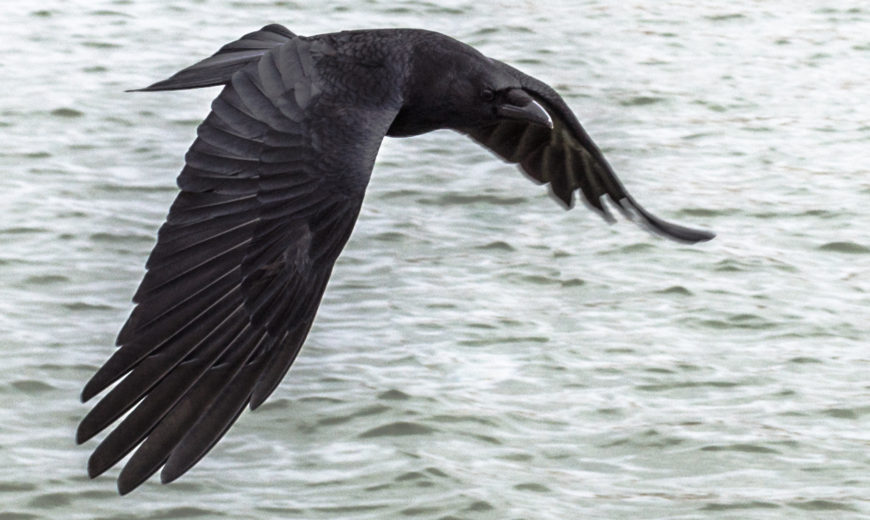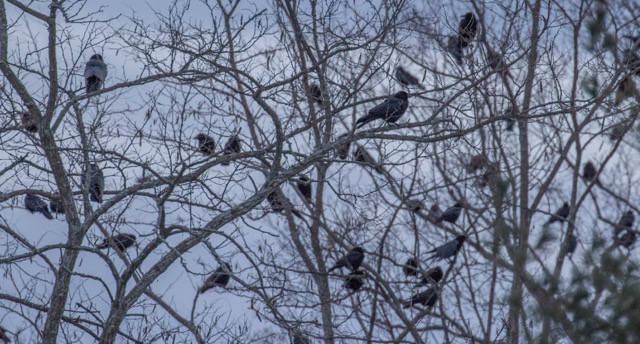What’s up with Winter Crows?

By Sean Beckett
“One for sorrow, Two for joy, Three for a girl, Four for a boy, Five for silver, Six for gold, Seven for a secret never to be told…”
Divining prophets throughout history have counted crows to foretell fortune, famine, war, and fertility. The number and direction from which crows flew was once interpreted like astrological signs to prophesize the fates of cities. Tibetan and Indian lore explains that crows streaming in from the east at dusk indicated either great fear or great honor. To the Greeks, crows brought messages from Apollo. To the Norse, they were a sign from Odin. Last month, a team of birdwatchers participating in Audubon’s annual Christmas Bird Count gazed skyward to record American Crows streaming into Burlington by the thousands. By counting crows, the birders hoped to reveal prophecies of our own city.
Perhaps you’ve witnessed their nightly invasion: An hour before dusk between November and March, above Pine Street, Flynn Ave, or Shelburne Road you’ve encountered a sky saturated with dark specks winging westward. Perhaps you’ve looked out your window in the South End to discover hundreds or thousands of them adorning the branches of old street trees and erupting into raucous bouts of deafening caws.

Though this crepuscular crow maelstrom incites superstition in even the most brazen birdwatcher, the event is actually an old Burlington tradition. The Queen City has hosted this nocturnal roost for decades, if not centuries. Longtime Burlington residents may remember a time when the crows descended on City Hall Park almost every night. The roost moves from day to day and year to year, and now the crows tend to convene in urban forests across the South End: the vacant post-industrial forested spaces off Pine Street, the fringes of Red Rocks and Queen City Park, or the urban greenway along Briggs Street are regular sites. Crows also stage in large groups at sites fringing the city, making mass group transfers over to the South End roost as dusk approaches. The UVM experimental dairy on Spear Street and the median trees on I-189 are common staging locations.
What do the crows stand to gain from amassing each night in the heart of our most developed landscapes? These downtown roosts puzzled biologists for a long time, but there are three recognized hypotheses that contribute to the explanation. The first is about safety in numbers. Crows frequently find themselves in the crosshairs of Great Horned Owls, against which they can neither defend from or even detect an attack. Roosting alone leaves a crow vulnerable and exposed to these stealthy hunters, but cozying up with a thousand of your ilk reduces your risk of being the one targeted by a resident owl.
The second theory is also a predator-avoidance tactic. Great Horned Owls are hunters of fields and forest edges in rural areas. They are rarely encountered in urban centers. Selecting downtown and industrial roosts keeps the crows from dozing off in an owl’s territory.
The third theory recognizes the roosts as critical information centers. Particularly in the winter months when food is scarce, crows seek out their peers to get the latest intel about the day’s freshest deer carcasses, fish kills, and compost piles. Though a lucky individual may benefit in the short-term by protecting this information (having your own carcass ensures a full belly in austere times), the savvy crow discovering such a windfall trades this information for social status—the crow who reliably finds prime food sources will be a much more attractive mate.
At the Christmas Bird Count, volunteers tallied 1,019 crows roosting on Dunder Road before running out of daylight. Fanned out across the city, the crow-counters verified that the South End hosted the only roost in greater Burlington. From atop Ethan Allen Tower, observers spotted crows winging toward the South End above Winooski, Colchester, and South Burlington. Two days later, over 2,000 birds were observed behind the water treatment facility on Queen City Park Road before darkness again stymied a full count.
Rarely in nature does the entire population of a species gather conveniently for counting each night. But despite being one of the most ostentatious and cosmopolitan demonstrations of natural history in the region, we have surprisingly little data about these roosts and the numbers of birds they comprise.
Cultures throughout history have been wise to the messages carried by crows. While they may not prophesize war and famine, these topics are not as farfetched as they seem. Ecologists are searching for indicators of the effects of human disturbance like climate change and development, and our crows may be an untapped, macabre canary in the coal mine. Crow population trends may offer clues to the effects of land use decisions on our wildlife, and patterns of roost locations may help us enumerate the value of our often-overlooked urban green space. Until we have a richer dataset, it’s hard to predict the information we can glean from counting crows.
So consider becoming a twenty-first century crow diviner. Following their daily migration is a bit like finding a pot of gold at the end of an eerie rainbow. Keep an eye to the sky and an ear out the window in the South End near dusk. Once you find them streaming overhead, triangulate their flight paths directly to the roost. Once you encounter the roost, please venture a count and report your information in the ongoing Crows in Vermont iNaturalist Project.
Crow observers who contributed information to this article include: Ali Wagner, Alice Christian, Andy Wood, Eric Lazarus, Allison Waring, Shirley Johnson, and Bruce MacPherson
Photo of closeup crow by Iain Wanless
Other photos by Sean Beckett

I found 4 crows walking in my front yard in Enosburg Falls. Is that strange? I’ve never seen that before.